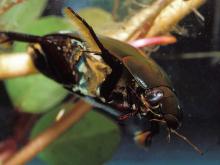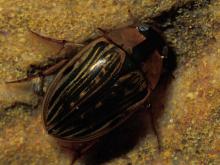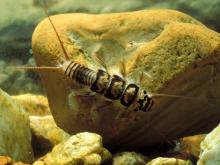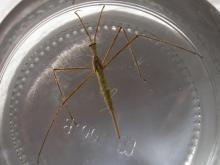Aquatic Invertebrates
Media

Species Types
Scientific Name
Species in the beetle family Dytiscidae
Description
Like many aquatic insects, these large oval beetles prey voraciously on other aquatic organisms. Excellent swimmers, they fly well, too, and are often attracted to lights.
Media

Species Types
Scientific Name
Beetles in the family Hydrophilidae
Description
Water scavenger beetles are a mostly aquatic family. They are similar to predaceous diving beetles, but unlike them many have a distinctive spine running down the center of their bellies.
Media

Species Types
Scientific Name
Species in the genera Abedus, Belostoma, and Lethocerus
Description
Giant water bugs are huge aquatic insects that frequently fly around electric lights at night. They are infamous for the painful bite they can deliver, but fish, birds — and some people — find them tasty!
Media

Species Types
Scientific Name
There are hundreds of species in North America
Description
Stonefly larvae are aquatic and somewhat resemble the larvae of mayflies and damselflies. Their presence usually indicates good water quality.
Media

Species Types
Scientific Name
Corydalus cornutus
Description
Hellgrammites are the aquatic larval form of eastern dobsonflies. They are fiercely predaceous and look a little like centipedes. Anglers often use them as bait.
Media

Species Types
Scientific Name
Ranatra spp. and Nepa apiculata
Description
Water scorpions remain still, looking like a random bit of plant material. Then they suddenly grab their prey and deliver disabling fluids with a quick jab of their knifelike beak.
See Also
About Aquatic Invertebrates in Missouri
Missouri's streams, lakes, and other aquatic habitats hold thousands of kinds of invertebrates — worms, freshwater mussels, snails, crayfish, insects, and other animals without backbones. These creatures are vital links in the aquatic food chain, and their presence and numbers tell us a lot about water quality.





















